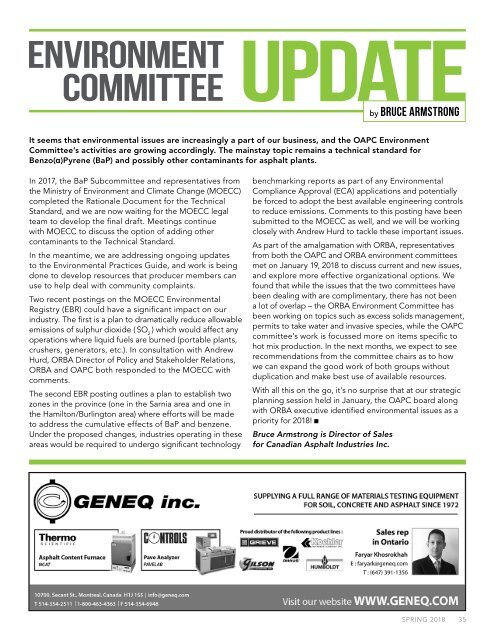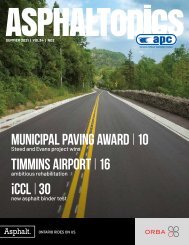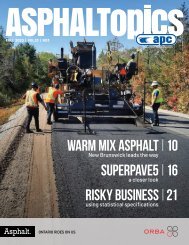ASPHALTopics | Spring 2018 | VOL 31 | NO 1
You also want an ePaper? Increase the reach of your titles
YUMPU automatically turns print PDFs into web optimized ePapers that Google loves.
ENVIRONMENT<br />
COMMITTEE Update<br />
by Bruce Armstrong<br />
It seems that environmental issues are increasingly a part of our business, and the OAPC Environment<br />
Committee’s activities are growing accordingly. The mainstay topic remains a technical standard for<br />
Benzo(α)Pyrene (BaP) and possibly other contaminants for asphalt plants.<br />
In 2017, the BaP Subcommittee and representatives from<br />
the Ministry of Environment and Climate Change (MOECC)<br />
completed the Rationale Document for the Technical<br />
Standard, and we are now waiting for the MOECC legal<br />
team to develop the final draft. Meetings continue<br />
with MOECC to discuss the option of adding other<br />
contaminants to the Technical Standard.<br />
In the meantime, we are addressing ongoing updates<br />
to the Environmental Practices Guide, and work is being<br />
done to develop resources that producer members can<br />
use to help deal with community complaints.<br />
Two recent postings on the MOECC Environmental<br />
Registry (EBR) could have a significant impact on our<br />
industry. The first is a plan to dramatically reduce allowable<br />
emissions of sulphur dioxide ( SO 2<br />
) which would affect any<br />
operations where liquid fuels are burned (portable plants,<br />
crushers, generators, etc.). In consultation with Andrew<br />
Hurd, ORBA Director of Policy and Stakeholder Relations,<br />
ORBA and OAPC both responded to the MOECC with<br />
comments.<br />
The second EBR posting outlines a plan to establish two<br />
zones in the province (one in the Sarnia area and one in<br />
the Hamilton/Burlington area) where efforts will be made<br />
to address the cumulative effects of BaP and benzene.<br />
Under the proposed changes, industries operating in these<br />
areas would be required to undergo significant technology<br />
benchmarking reports as part of any Environmental<br />
Compliance Approval (ECA) applications and potentially<br />
be forced to adopt the best available engineering controls<br />
to reduce emissions. Comments to this posting have been<br />
submitted to the MOECC as well, and we will be working<br />
closely with Andrew Hurd to tackle these important issues.<br />
As part of the amalgamation with ORBA, representatives<br />
from both the OAPC and ORBA environment committees<br />
met on January 19, <strong>2018</strong> to discuss current and new issues,<br />
and explore more effective organizational options. We<br />
found that while the issues that the two committees have<br />
been dealing with are complimentary, there has not been<br />
a lot of overlap – the ORBA Environment Committee has<br />
been working on topics such as excess solids management,<br />
permits to take water and invasive species, while the OAPC<br />
committee’s work is focussed more on items specific to<br />
hot mix production. In the next months, we expect to see<br />
recommendations from the committee chairs as to how<br />
we can expand the good work of both groups without<br />
duplication and make best use of available resources.<br />
With all this on the go, it’s no surprise that at our strategic<br />
planning session held in January, the OAPC board along<br />
with ORBA executive identified environmental issues as a<br />
priority for <strong>2018</strong>!<br />
Bruce Armstrong is Director of Sales<br />
for Canadian Asphalt Industries Inc.<br />
SPRING <strong>2018</strong> 35

















